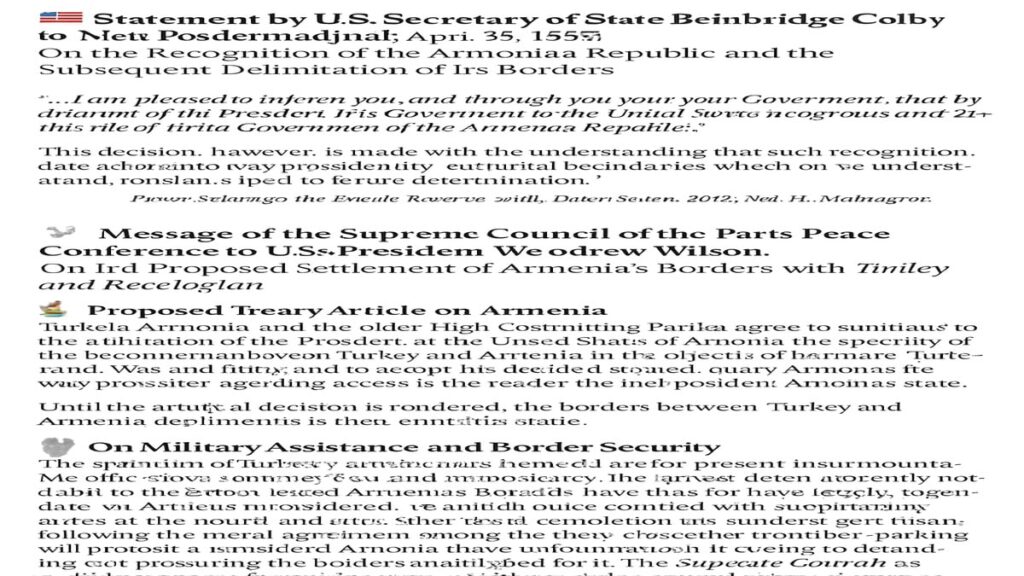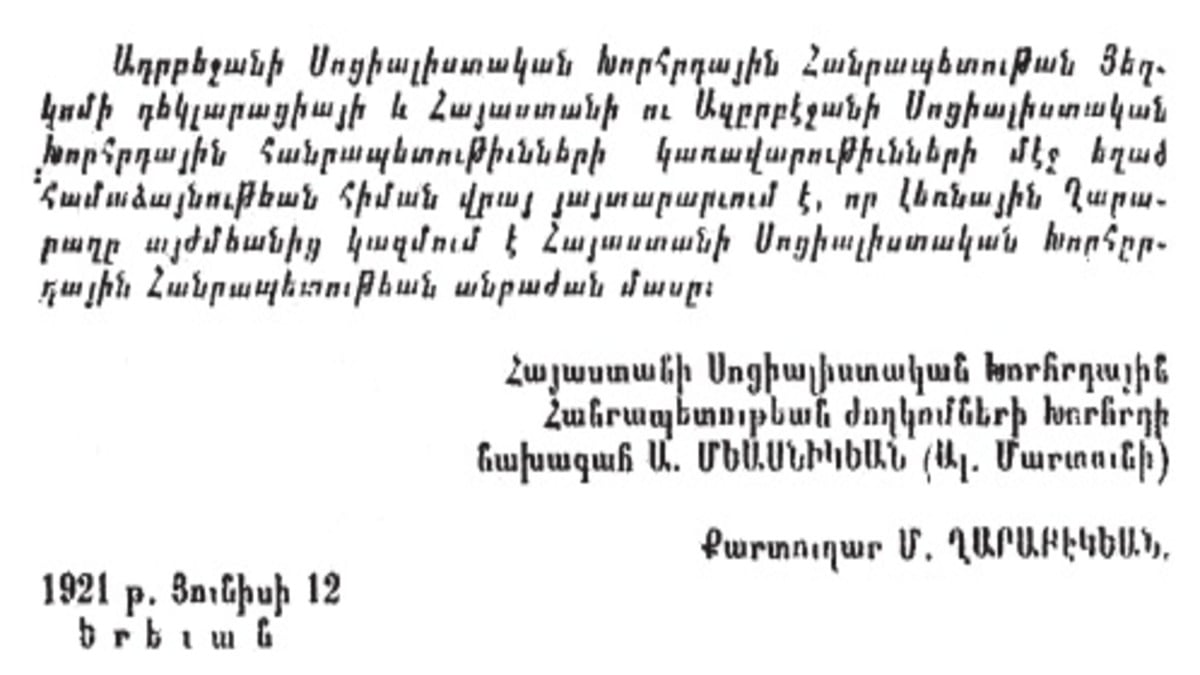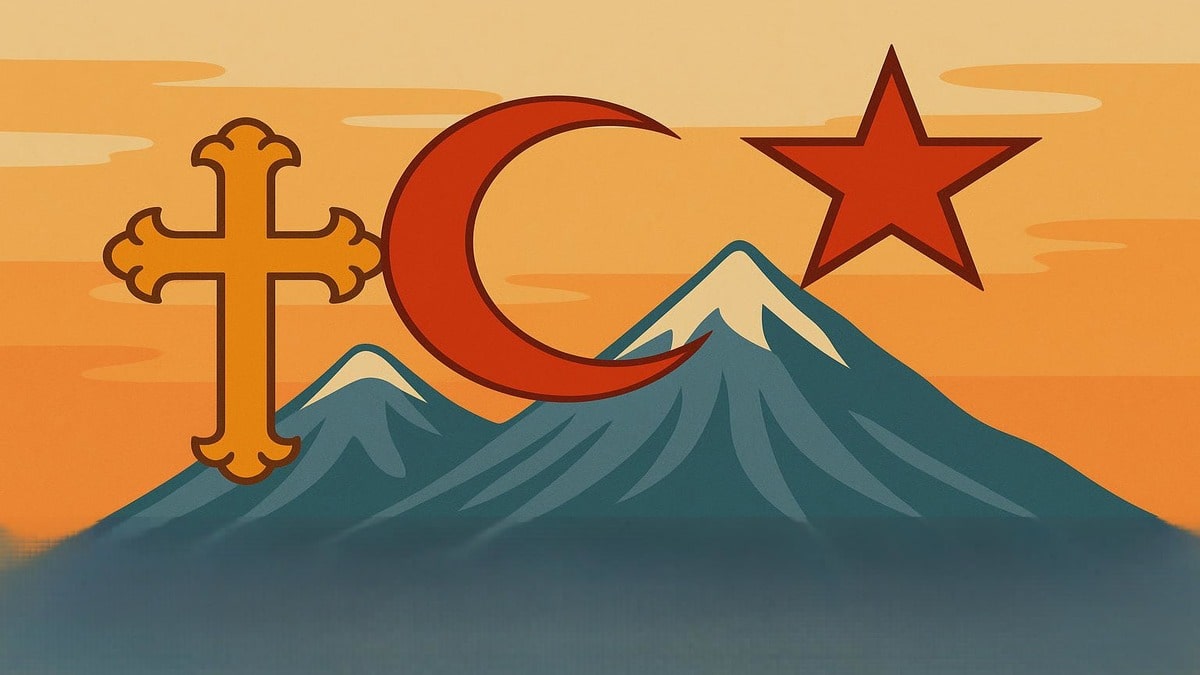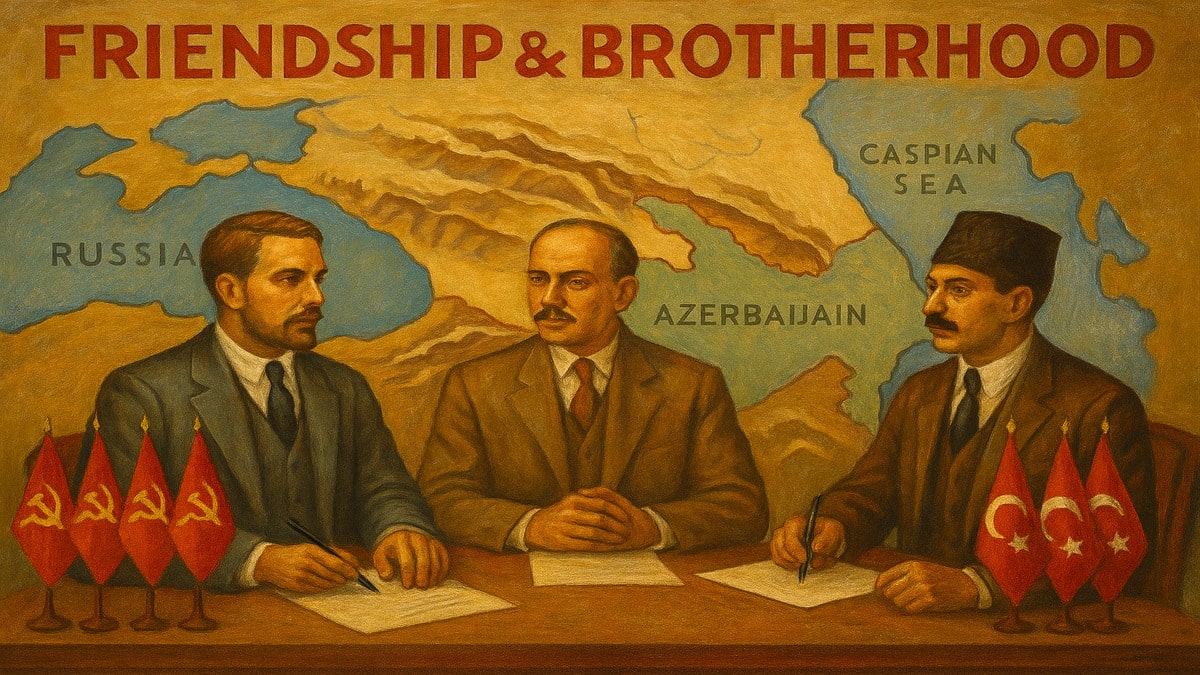
February 12 – March 10, 1920
[No. 1]
I.C.P. 24 – Minutes of the session of the Allied Powers Conference held at 10 Downing Street, S.W.1, on February 12, 1920, at 11:00 a.m. Recorded by the British Secretary.
Present:
- British Empire: The Right Honourable Prime Minister D. Lloyd George; The Right Honourable Foreign Secretary, Earl Curzon; Secretary: Sir M. Hankey
- France: President of the Council of Ministers Mr. Millerand; Mr. Berthelot; Secretary: Mr. de Béarn
- Italy: President of the Council of Ministers Mr. Nitti; Secretary: Mr. Trombetti
- Interpreter: Professor P. J. Mantoux
Mr. Lloyd George proposed that the Council begin with a general discussion of the work of the forthcoming Peace Conference…
[No. 10]
I.C.P. 32 – Minutes of the session of the Allied Powers Conference held at 10 Downing Street, S.W.1, on February 16, 1920, at 6:30 p.m. Recorded by the British Secretary.
Present:
- British Empire: The Right Honourable Prime Minister D. Lloyd George; The Right Honourable Foreign Secretary, Earl Curzon; Mr. Vansittart; Mr. Forbes Adam; Secretaries: Sir M. Hankey, Major Caccia
- France: Mr. Cambon; Mr. Berthelot; Mr. Cammerer; Mr. de Fleury
- Italy: Mr. Nitti; Mr. Galli; Secretary: Mr. Trombetti
- Japan: Viscount Tinda
- Interpreter: Professor P. J. Mantoux
Lord Curzon stated that the Armenian question had both political and geographical dimensions. The geographical aspect concerned the delineation of borders—a matter that could only be resolved by a commission operating on the ground. Politically, the Allies had fought to secure the establishment of an independent Armenia, a goal they had all equally pledged to achieve.
He suggested focusing the discussion on the nature and boundaries of the proposed Armenian state. Two views were expressed: one advocated for a Greater Armenia encompassing six Turkish vilayets and stretching from the Black Sea to the Mediterranean; the other supported a smaller Armenian state. The core of the Armenian state already existed in the autonomous Russian Armenia with its capital in Erivan. The Paris Conference had recognized the independence of this de facto state, and the remaining task was to determine what territorial additions were necessary.
The British government welcomed the creation of an independent Armenian state under the auspices of the League of Nations. At one point, it was assumed that the United States would accept the mandate for Armenia. This now seemed unlikely, although the U.S. would probably provide financial assistance. Lord Curzon expressed doubt that the Council would invite a neutral power to assume the mandate, though he mentioned it as a possible alternative. In his view, the best solution would be a League of Nations protectorate over Armenia.
In the eastern or Caucasian part of the new Armenian state, borders would need to be established with Georgia and Azerbaijan. Fortunately, friendly relations had recently developed among these states, and he believed that border lines should be determined by a commission on the ground.
Although relations between Armenia and Azerbaijan were currently amicable, he acknowledged that certain border areas—specifically Zangezur and Karabakh—remained disputed and would be difficult to resolve.
📜 Appendix No. 3 to No. 11
Commission on Armenia – Terms of Reference (Secret)
It was decided to establish a commission composed of two representatives from each of the following powers: the British Empire, France, Italy, and Japan. The commission was tasked with reviewing the claims of the Armenian delegation and issuing recommendations:
- (a) Regarding the geographical boundaries of Armenia, based on the following premises:
- Armenia should be established as an independent state
- It should include the currently recognized de facto Republic of Erivan and parts of adjacent Turkish vilayets
- Measures should be taken to protect the Armenian population in Cilicia
- (b) Regarding the future status of Batum and the Sanjak of Lazistan
[No. 34]
I.C.P. 47 – Minutes of the Meeting of Foreign Ministers and Ambassadors held in the office of the Foreign Secretary at the British Foreign Office, Whitehall, S.W.1, on February 27, 1920, at 6:00 p.m. Recorded by the British Secretary.
Present:
- British Empire: The Right Honourable Foreign Secretary, Earl Curzon; Mr. Vansittart; Mr. Malkin (Protocol 1); Colonel Gibbon; Secretaries: Lieutenant Colonel Storr, Major Caccia, Major Young
- France: Mr. Cambon; Mr. Berthelot; Colonel Chardigny; Mr. Cammerer
- Italy: Mr. Schalloya; Marquis Imperiali; Duke Ascanio Colonna; Mr. Galli; Colonel Castoldi
- Japan: Viscount Tinda; Mr. Magaoka [Nagaoka]
(c) Lord Curzon explained that regarding the borders between Armenia, Georgia, and Azerbaijan, the commission recommended that the Council await the outcome of agreements anticipated under existing treaties among the three states. He noted that the disputed areas included Karabakh, Kangeor [Zangezur], and Nakhichevan. These regions were predominantly populated by Armenians, with the exception of one area inhabited almost entirely by Tatars. He believed the Council could not resolve this issue at present and that the commission’s recommendation should be accepted.
It was agreed that the decision on borders between Armenia, Georgia, and Azerbaijan should be postponed until an agreement was reached among the three republics. Afterward, an inter-Allied commission would be tasked with demarcating the boundary lines.
📄 Appendix No. 1 to No. 71
Report on the Creation of the Future Armenian State (A.J.120)
The commission entrusted with preparing the report on the creation of the future Armenian state had the honor of submitting the enclosed draft articles for inclusion in the treaty with Turkey.
These articles were based on the commission’s initial report, previously submitted to the Council, but had to be amended for reasons and to an extent explained below.
Armenia Article 1 Turkey, in accordance with actions already taken by the Allied Powers, hereby recognizes Armenia as a free and independent state and renounces in favor of Armenia all rights and titles to the territory of the Turkish Empire lying beyond the borders of Turkey as defined in Article <…>, and included within the limits set forth in Article 2.
Article 2 The borders of Armenia shall be established as follows:
- With Turkey and Kurdistan <…>
Article 4 The borders between Armenia and Azerbaijan, and likewise with Georgia, shall be determined through direct agreements between these states.
If no agreement is reached within six months of the treaty’s entry into force, the boundary lines in question shall be determined by the Principal Allied Powers, who shall also undertake demarcation on the ground.
🛡️ Report by British Representative Mr. G. Fisher
On the Necessity of Protecting the Armenian State Appendix 30c to the Minutes of the Fourth (Closed) Session, Fourth Session of the Council of the League of Nations April 11, 1920
The Future Status of Armenia
In a telegram dated March 12 of this year, Lord Curzon, acting as Chairman of the Conference of Foreign Ministers and Ambassadors meeting in London, asked the Council of the League of Nations whether it was prepared to assume, on behalf of the League, the protection of the future independent Armenian state.
The Council of the League was unable to respond immediately, as the matter required the most careful deliberation. Since then, having received further clarification from the Conference of Foreign Ministers and Ambassadors following special meetings held in Paris from April 9 to 11, the Council has examined the issue in all its essential aspects. I am authorized by my colleagues on the Council to present the conclusions they have reached unanimously.
The Council of the League holds the view that the establishment of the State of Armenia, founded on the principles of liberty, security, and independence, is a goal that deserves—and will undoubtedly receive—the sympathy and support of enlightened opinion throughout the civilized world. The sufferings recently endured by the ancient Armenian people are well known. In scale and cruelty, they surpass any atrocity recorded in the annals of human history. If we fail to find a way to safeguard this unfortunate people from a repetition of the catastrophe they have just survived, it would indeed be a sign that the capabilities of civilization have reached their lowest ebb.
The Council believes that the most desirable solution, recognized as such by all parties, would be for a civilized state to accept a mandate for Armenia under the auspices of the League of Nations. It is believed that the Armenians would welcome such a decision. It would provide the most effective and prosperous form of governance and align with measures recently planned under League supervision in other parts of Asia, where political conditions are not significantly different. However, the question arises whether any state is willing to assume such responsibility. The Council considers that the answer depends partly on the military measures that may be required to liberate the territory and secure the borders of the new state, and partly on financial capacity.
🗺️ Decision of the Allied Powers Conference in San Remo
On the Territory and Borders of Armenia April 18–26, 1920
Mr. Nitti stated that he had no doubt Armenia was in a very difficult situation. Moreover, the Russians (Tatars) might advance southward, and it was not impossible that the Georgians could seize the opportunity to attack. Therefore, the Armenians must consider how to defend their borders against Georgia, the Tatars, the Russians, and the Turks.
Marshal Foch remarked that he saw no possibility of providing military support to Armenia from the Allied forces. Furthermore, it would be extremely difficult for the Armenians to establish a new state and armed forces, given that they were currently surrounded by hostile elements.
[No. 16]
I.C.P.106 – Minutes of the Supreme Council Meeting held at “Villa Devachan,” San Remo, April 25, 1920, 11:00 a.m. Recorded by the British Secretary.
Present:
- United States of America: Mr. Robert Underwood Johnson, U.S. Ambassador to Rome; Secretaries: Mr. Leland Harrison, Mr. T. Hart Anderson
- British Empire: The Right Honourable D. Lloyd George, Prime Minister; The Right Honourable Earl Curzon, Foreign Secretary; Mr. R. Vansittart, Colonel Gribbon, Mr. E. F. Wise
- France: Mr. Millerand, President of the Council of Ministers; Mr. Berthelot, Mr. Cammerer
- Italy: Mr. Nitti, Prime Minister (Chairman); Mr. Schalloya; Secretaries: Mr. Garbasso, Mr. Galli, Mr. Trombetti, Lieutenant Zanchi
- Japan: Mr. Matsui; Secretaries: Mr. Saito, Mr. Sawada
- Interpreter: Mr. Camerlynck
🇬🇧 British Proposal on Armenian Borders
Mr. Nitti stated that at the previous day’s Council meeting, Mr. Lloyd George had committed, on behalf of the British delegation, to present a draft resolution regarding the borders of the future Armenian state.
The official interpreter then read the British proposal in French and English:
- (a) To request President Wilson that the United States accept a mandate for Armenia within the boundaries defined in Part III, Section V of the first draft of the Peace Treaty with Turkey
- (b) If the United States is unwilling to accept the mandate, then President Wilson should be asked to act as arbitrator in determining the borders of Armenia, as outlined in the following draft article
- (c) The article concerning Armenia should be included in the Peace Treaty in the following form:
“Turkey, Armenia, and the other High Contracting Parties agree to submit to the arbitration of the President of the United States of America the question of the boundaries between Turkey and Armenia in the vilayets of Erzerum, Trebizond, Van, and Bitlis, and to accept his decision, as well as any proposal he may make regarding access to the sea for the independent Armenian state. Until the arbitration decision is rendered, the borders between Turkey and Armenia shall remain as they currently stand. The borders of Armenia to the north and east—that is, with Georgia and Azerbaijan—shall be determined by the Supreme Council concurrently with the borders between Armenia and Turkey, unless the three Caucasian states reach a voluntary agreement on the matter.”
- (d) The Drafting Committee, in consultation with other relevant committees of the Conference as necessary, shall incorporate the appropriate additions to Part III, Section V of the Treaty and make all other necessary amendments.
Mr. Berthelot, on behalf of the French delegation, stated his agreement with the proposed draft.
🇺🇸 Statement by U.S. Secretary of State Bainbridge Colby to Pasdermadjian
On the Recognition of the Armenian Republic and the Subsequent Delimitation of Its Borders April 23, 1920
“…I am pleased to inform you, and through you your Government, that by direction of the President, the Government of the United States recognizes, as of today, the de facto Government of the Armenian Republic. This decision, however, is made with the understanding that such recognition does not in any way prejudge the territorial boundaries, which, as we understand, remain subject to future determination.” —Papers Relating to the Foreign Relations of the United States, 1920. Vol. III, Washington, 1936, p. 778
🕊️ Message of the Supreme Council of the Paris Peace Conference to U.S. President Woodrow Wilson
On the Proposed Settlement of Armenia’s Borders with Turkey and Azerbaijan April 26–27, 1920
In reference to my telegrams No. 5 and No. 11 from San Remo: On Monday, April 26, at noon, the Supreme Council of the Allied Powers approved the draft message to President Wilson concerning Armenia, as presented by Lord Curzon. It was decided that Mr. Nitti would sign the message and that it would be transmitted through me. The message reads:
“In the note of this date addressed to the Government of the United States, in reply to its note of March 26, a reference was made in passing to the question of Armenia, and it was stated that a separate communication would be sent on this matter. The following are the considerations which the Supreme Council wishes to submit to the American Government.
At the outset of discussions regarding the treaty with Turkey—first in London, then in Paris—the Allied Conference consulted the Council of the League of Nations, which, as is well known, takes a deep interest in the fate of Armenia, to determine what degree of assistance the League might offer to ensure the independence and security of the proposed Armenian state.
It was never intended to propose that the League itself assume the mandate for Armenia, for the simple reason that the League is not a state and lacks both military forces and the financial means to fulfill such obligations. In its reply, the Council of the League expressed full sympathy with the aims of the Allied Powers and emphasized that the best course would be to find a member of the League or another power willing to accept the mandate for Armenia.
Upon reviewing this response, the Supreme Council reaffirmed its long-held belief that the only great power both inclined and materially equipped to undertake this task in the interest of humanity is America. Secretary Colby rightly stated that ‘the civilized world awaits and demands’ the fulfillment of this responsibility. The Supreme Council cannot forget that no one spoke more eloquently than President Wilson about including the liberation of Armenia among the goals for which the Allied and Associated Powers fought and triumphed in the war.”
📜 Proposed Treaty Article on Armenia
“Turkey, Armenia, and the other High Contracting Parties agree to submit to the arbitration of the President of the United States of America the question of the boundaries between Turkey and Armenia in the vilayets of Erzerum, Trebizond, Van, and Bitlis, and to accept his decision, as well as any measures he may prescribe regarding access to the sea for the independent Armenian state.
Until the arbitral decision is rendered, the borders between Turkey and Armenia shall remain as they currently stand.
The borders of Armenia to the north and east—that is, with Georgia and Azerbaijan—shall be determined by the Supreme Council concurrently with the borders between Armenia and Turkey, unless the three Caucasian states reach a voluntary agreement on the matter.”
🛡️ On Military Assistance and Border Security
The question of military assistance is believed not to present insurmountable difficulties, contrary to initial impressions. The armed forces currently available to the Erivan-based Armenian Republic have thus far been largely expended—or perhaps squandered—in unfortunate conflicts with neighboring states to the north and east. Once these conflicts are resolved, as hoped following the recent agreement among the three Caucasian republics, nothing will prevent a revitalized Armenia from dedicating its full energy to defending and preserving the borders established for it.
The Supreme Council carefully considered the extent to which the Allied Powers themselves might, through troop movements, ensure the swift implementation of the territorial provisions of the treaty in the Armenian region. Arms and ammunition are already being allocated, but if a general belief were to arise that the Allied Powers might deploy their own forces for this purpose, it would only foster false hopes among the Armenians and their supporters worldwide. 605
Yuri Barsegov “Nagorno-Karabakh in International Law and Global Politics”
Artatsolum
Read Also:
- Ancient and Medieval Sources on Artsakh (Karabakh) as Part of Armenia’s State Territory
- Message from Gandzasar Catholicos Esayi to Peter I August 10, 1716
- Memorandum Issued to Ivan Karapet Along with the Imperial Letter to the Armenian People Regarding Russia’s Readiness to Take the Armenians of Karabakh Under Its Protection June 3, 1723
- Decree of Peter I to the Armenian People Regarding Russia’s Willingness to Offer Protection to the Armenians of Karabakh
- On Armenian Hopes for Russian Assistance
- Report of Minas Vardapet to Peter I
- Contents of the Secret Letters from the Armenian Assembly and the Armenian Army of Karabakh to the Russian Emperor and Chancellor August 1724
- Contents of the Secret Letters from the Armenian Assembly and the Armenian Army of Karabakh to the Russian Emperor and Chancellor August 1724
- State Charter of Peter I On the Acceptance of the Armenian People Under the Protection of the Russian State and Their Resettlement from Karabakh to Newly Acquired Persian Provinces November 10, 1724
- Letters from the Catholicos and the Meliks of Karabakh
- Charter of Catherine I Addressed to the Armenian Assembly
- Message General Mkhitar—to the Russian Government
- The Armenian Assembly’s Request for Military Assistance June 19, 1727
- Result from Russia’s failure to fulfill its promises of assistance to the Armenians March 1736
- On the Issuance of the Decree Appointing Panah Khan
- Letter from General Potemkin to Prince Argutinsky with questions about the liberation of Armenia
- Appeal of Gandzasar Catholicos Hovhannes to Catherine II
- Letter from Melik Apov Iosifov to Provide Assistance to Russian Military Forces for the Liberation of Enslaved Karabakh
- Report of Prince G. Potemkin to Catherine II
- Request of General P. Potemkin to Prince G. Potemkin
- Letter from Archbishop Joseph Argutinsky to General P. Potemkin
- Memorandum to Catherine II on the Project for the Restoration of the Armenian Kingdom
- Decree of Paul I to General Count I. Gudovich
- Letter from Archbishop Joseph Argutinsky
- Report by State Councillor P. Kovalesky
- The Khan’s Vizier, Mirza Jamal Javanshir Karabakhsky
- From the Report of General Marquis Palluci to Alexander I
- The Gulistan Treaty – An Interstate Act of Iran’s Cession of the Karabakh Territory to Russia
- Report of General A. Yermolov to Alexander I Requesting the Waiver of Tax Arrears for the Karabakh Khanate
- LETTER FROM GENERAL A. YERMOLOV TO MEHTI-KULI KHAN
- Directive from General A. Yermolov to General I. Velyaminov
- Letter of Metropolitan Sarkis Hasan-Jalalyan To General A. Yermolov
- Letter from General I. Paskevich
- TREATY CONCLUDED BETWEEN RUSSIA AND PERSIA AT TURKMENCHAY
- Russian Military Historian V. Potto on the Essence of the Treaty of Turkmenchay
- Order of General I. Paskevich to Colonel L. Lazarev
- STATEMENT ON THE DIFFERING ATTITUDES OF ARMENIANS AND TATARS TOWARD THE ANNEXATION OF KARABAKH TO RUSSIA
- REPORT By the Acting Uezd Chief of the Dzhevanshir Uezd, D. Baranovsky
- From the Memoirs of a Member of the Russian National Council in Baku (1918–1919)
- “TREATY OF PEACE AND FRIENDSHIP” Between the Ottoman Empire and the Republic of Armenia
- Letter from A. Mikaelyan, Representative of the Karabakh and Zangezur Fellowship
- Note of Protest from the Ministry of Foreign Affairs of the Republic of Armenia
- Appeal of the Karabakh Armenian National Council To the Commander of Allied Forces in Baku
- LETTER FROM THE CHAIRMAN OF THE KARABAKH ARMENIAN NATIONAL COUNCIL
- Turks in Shushi
- Letter of Welcome from the Karabakh Armenian
- LETTER FROM GENERAL BAGRATUNI
- FROM THE MESSAGE OF THE ARMENIAN TELEGRAPH AGENCY
- REPORT FROM THE DIPLOMATIC REPRESENTATIVE OF ARMENIA IN GEORGIA
- Resolution of the Fifth Congress of Armenians of Karabakh
- Report by Prime Minister Hatisov to the Council of Ministers of Armenia
- FROM THE MEMORANDUM OF THE KARABAKH ARMENIAN NATIONAL COUNCIL
- 🇬🇧 ANNOUNCEMENT OF THE BRITISH MILITARY MISSION IN SHUSHA
- From the Memorandum of the Armenian Representative to the British Military Mission in Shusha
- Report from the Office of the Governor-General of Karabakh
- NOTICE FROM THE REPRESENTATIVE OF THE BRITISH MILITARY MISSION IN SHUSHI
- 🇬🇧 Doubts Expressed by British Delegate Eric Forbes Adam
- LETTER FROM THE ARMENIAN DIPLOMATIC REPRESENTATIVE
- Assessment by the Karabakh Armenian National Council
- “The Caucasian Word” on the Confirmation by a British Command Representative
- Letter from the Acting Governor-General of Karabakh
- OVERVIEW OF THE SITUATION IN THE CAUCASUS
- Proclamation of the Zangezur Armenian National Council
- Telegram from the Prime Minister of Armenia to the British High Commissioner
- MESSAGE TO THE DIPLOMATIC REPRESENTATIVE
- Photographic Evidence of the Annihilation of Shushi’s Thirty-Thousand Strong Armenian Population
- Appeal of the Karabakh Soldiers and Officers of the Armenian Army
- Territorial Dispute Between the Azerbaijan SSR (as part of the RSFSR) and the Republic of Armenia
- Telegram from the Minister of Foreign Affairs of Armenia
- Telegram from G. Ordzhonikidze to V. Lenin, I. Stalin, and G. Chicherin
- LETTER FROM MEMBERS OF THE CAUCASIAN BUREAU OF THE CENTRAL COMMITTEE OF THE RCP(B): A. AVANESOV, R. KATANYAN, AND AYKUNI
- Report of the Karabakh Community Delegation of Tiflis
- From the Report of People’s Commissar for Foreign Affairs of the RSFSR
- Letter from the People’s Commissar for Foreign Affairs of the RSFSR, G. Chicherin, to V. Lenin
- EXCERPT FROM THE MINUTES OF THE MEETING OF THE POLITBURO
- LETTER FROM MEMBERS OF THE CAUCASUS BUREAU OF THE CENTRAL COMMITTEE OF THE RCP(B)
- LETTER FROM MEMBERS OF THE CAUCASUS BUREAU OF THE CENTRAL COMMITTEE OF THE RCP(B) 11TH RED ARMY
- Telegram from the People’s Commissar for Foreign Affairs of the RSFSR, G. Chicherin
- Appeal from the Commander of the Armenian Expeditionary Detachment
- TELEGRAM OF THE PLENIPOTENTIARY REPRESENTATIVE OF THE RSFSRIN ARMENIA B. LEGRAND
- Letter from Armenian Foreign Minister A. Ohandjanian to the Head of the French Military Mission
- Telegram from Member of the Caucasian Bureau of the Central Committee
- Telegram from Member of the Caucasian Bureau of the Central Committee of the RCP(b)
- First Addendum to the Draft Peace Treaty between the RSFSR and the Republic of Armenia
- Telegram via Direct Line from RVS Member of the Caucasian Front V. Trifonov
- THE ATTITUDE OF THE ALLIED HIGH COMMISSIONER IN ARMENIA, COLONEL GASKELL, TOWARDS THE ARBITRARILY ESTABLISHED BORDERS OF THE TRANSCAUCASIAN STATES


